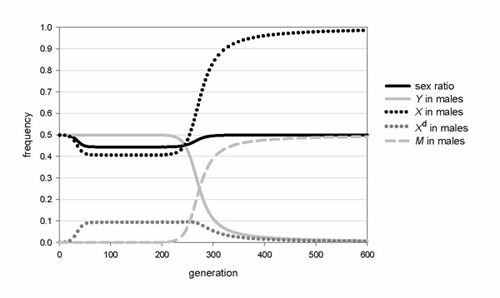Segregation distortion and the evolution of sex determining mechanisms
Most chromosomes follow "fair" Mendelian segregation, resulting in each of the homologues being present in (approximately) 50% of gametes. However, some genetic elements are recovered in more than half of the functional gametes of heterozygous individuals showing so-called segregation distortion or meiotic drive. Segregation distortion is advantageous at the gene level, since distorter alleles have transmission advantage and their frequency in the population will increase. However, the presence of a driving chromosome is usually not neutral with respect to individual fitness, leading for example to sterility or lethality of homozygous individuals. When segregation distorters are located on sex chromosomes, they not only have an effect on individual fitness, but also lead to biased sex ratios in the population. Biased sex ratios in turn are expected to select for changes in sex determining mechanisms.
We made a model in which we analyze the conditions for the spread of new sex determining factors in a system with a driving sex chromosome. We consider three scenarios: a driving X chromosome, a driving Y chromosome, and a driving autosome with a male determining factor. We investigate how the invasion prospects of a new sex determining factor are affected by the strength of distortion and the fitness effect of the distorter allele.

We show that in many cases meiotic drive may induce changes in the sex determining mechanism. When the drive leads to female biased sex ratios, a new masculinizing gene can invade leading to male heterogamety at a new locus. When the drive leads to male biased sex ratios, a feminizing factor can invade, leading to a switch to female heterogamety. Although the presence of driving alleles induces the spread of new sex determining factors, the change in the sex determining system may eventually lead to loss of the driving alleles from the population (for example, see figure 10). Therefore, distorter alleles may be present in population only in a transient state between changeovers of sex determining mechanisms. This shows that it may be difficult to infer the past forces responsible for changes in sex determining systems and the role of meiotic drive in this process may be underestimated.
| Last modified: | 03 December 2015 12.54 p.m. |
